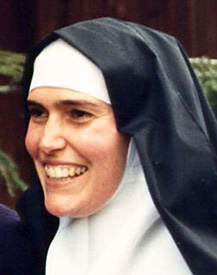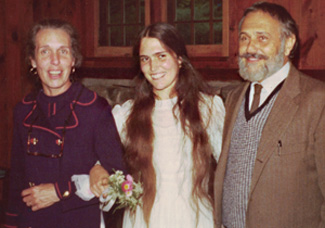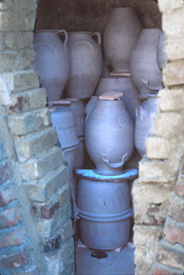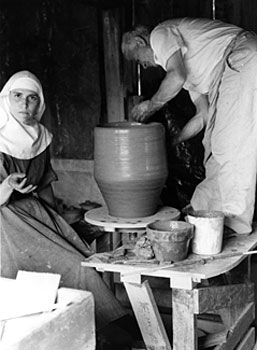
 |
|
|

 Mother Perpetua (née Laura) Giampietro, 69, died on February 7, 2019, after a long illness. She had a great love for monastic liturgy and Gregorian Chant and for many years served as Mistress of Ceremonies to which she brought her natural grace and love of dance. She was an accomplished potter who apprenticed under masters such as Emanuele Rondinone in Southern Italy. She established St. Martin's pottery complex, teaching pottery to community members and interns. She was a gifted seamstress, worked in the Monastic Infirmary, and also started the Abbey's first Compost Department. Mother Perpetua heroically battled early onset Alzheimer's disease for the last ten years of her life. Mother Perpetua (née Laura) Giampietro, 69, died on February 7, 2019, after a long illness. She had a great love for monastic liturgy and Gregorian Chant and for many years served as Mistress of Ceremonies to which she brought her natural grace and love of dance. She was an accomplished potter who apprenticed under masters such as Emanuele Rondinone in Southern Italy. She established St. Martin's pottery complex, teaching pottery to community members and interns. She was a gifted seamstress, worked in the Monastic Infirmary, and also started the Abbey's first Compost Department. Mother Perpetua heroically battled early onset Alzheimer's disease for the last ten years of her life.Laura Catherine Antoinette was born in Washington, D.C., the second of eleven children to Daphne and Professor Alexander Giampietro. Alexander, a native of Marsicovetere, Italy, was an internationally-regarded sculptor and ceramic artist who taught at The Catholic University of America for over 40 years. While pursuing a Master of Fine Arts degree at Alfred University N.Y., he met his future wife Daphne Phillips who was studying ceramics at the University. In their home, filled with sculpture, ceramics, and works of their hands, they raised eleven children, and instilled in them a love of beauty, striving to make art and music a part of everyday life.  When Professor Giampietro was on a Fulbright Fellowship in Italy from 1971-1972 his entire family participated. Laura apprenticed at the Ceramic Factory Urbano Zaccagnini Majolica Artistiche and studied under a traditional pottery master in Grottole. When Professor Giampietro was on a Fulbright Fellowship in Italy from 1971-1972 his entire family participated. Laura apprenticed at the Ceramic Factory Urbano Zaccagnini Majolica Artistiche and studied under a traditional pottery master in Grottole. Laura was taught by religious communities in Washington D.C., first by Notre Dame Sisters at the Campus School of Catholic University, and from the third through seventh grades by the Benedictine nuns of St. Anthony Parish School. She attended high school at Stone Ridge Country Day School of the Sacred Heart, graduating with high honors. Laura received a scholarship to Newton College of the Sacred Heart, Newton, Massachusetts and after attending for two years, transferred to The Catholic University of America, graduating with a Bachelor of Arts in 1971. While at Newton College of the Sacred Heart Laura and her classmate and friend Adele Hinckley (Mother Telchilde) had the inspiration to visit a monastery over Thanksgiving vacation. Regina Laudis Monastery answered their request for hospitality and welcomed them. The students found refuge in the monastic environment: the chanting of the psalms in Latin and the nuns' work with their hands and closeness to the earth.    Comparing herself to a vessel, she asked her grieving father: "Do you see, let us say, this vessel lying here to be a little pitcher, or something else? Can it be called by any other name than what it is? Neither can I call myself anything else than what I am, a Christian." Comparing herself to a vessel, she asked her grieving father: "Do you see, let us say, this vessel lying here to be a little pitcher, or something else? Can it be called by any other name than what it is? Neither can I call myself anything else than what I am, a Christian."The image of the vessel would play an important role in Mother Perpetua's mission and monastic life. Her two-week apprenticeship with master folk potter Emanuele Rondinone in Grottole, Matera, Southern Italy in 1971, found continuity in two summer seminars with Signor Rondinone directing the Closed Community in the building and firing of a traditional earthenware kiln at the Abbey. The firing of the kiln takes three days with teams continuously feeding the mouth of the kiln day and night with bundles of brush gathered for weeks in advance. The heat of the fire is monitored closely so it rises slowly, finally reaching the point of high fire. The "high fire" was a rich source of analogy for Mother Perpetua, as it is the transformative moment when clay is changed irrevocably into a pot, vase, or bowl. The opening of the kiln after three days of cooling down is the moment of truth—did the kiln reach high fire slowly enough, are pots strong and solid or shattered? 
Signor Emanuele Rondinone Mother Perpetua's many professional relationships allowed the expansion of the Abbey's pottery department. In 1982 her father, Professor Giampietro, directed the construction and firing of a Raku Kiln. This ancient Japanese low-firing technique, removing pots from a red-hot kiln and plunging them into cold water, creates stunning crackling in the glaze and clay. In 1984 Douglas Phillips, master potter from England, directed the building of a stoneware wood burning kiln at the Abbey. Mother Perpetua often used the Japanese technique of repairing cracks in pots with a special lacquer dusted with powdered gold. The repaired pot, more beautiful than the original, inspired in her the hope that our flaws and imperfections need not be hidden, but in the hands of the Potter can be transfigured.
The day of their victory dawned, and they marched from the prison to the amphitheater joyfully as though they were going to heaven, with calm faces, trembling, if at all, with joy rather than fear. Perpetua went along with shining countenance and calm step, as the beloved of God, as a wife of Christ, putting down everyone's stare by her own intense gaze.
From the Passion of Saints Perpetua and Felicity, Carthage, 203 A.D. Mother Perpetua is survived by her monastic community, her mother Daphne, her siblings: Matilda, Isabelle and her husband George, Joseph and his wife Sharon, Mary and her husband Larry, Frances, Martha, Charles and his wife Rosellyn, Rev. Father Anthony, C.S.B., Teresa and her husband Mickey, Gordon and his wife Mia, and numerous beloved nieces and nephews. She was predeceased by her father Alexander. The loving care of Mother Perpetua by the nurses and staff of the Lutheran Home and Hartford HealthCare at Home–Hospice Care is gratefully acknowledged.
Calling hours will be at the Abbey Church Jesu Fili Mariae at 15 Robert Leather Road in Bethlehem on Sunday, February 10th from 2:30—5:00 pm, followed by Vespers, and on Monday, February 11th beginning at 9:00 am followed by the Requiem Mass at 10:00 am and burial in the Abbey cemetery. In lieu of flowers, donations to the New Horizons Renovation Project would be gratefully accepted on-line or c/o The Abbey of Regina Laudis, 273 Flanders Road, Bethlehem, CT 06751. |
||
| Copyright © 2013 Abbey of Regina Laudis. All rights reserved. | |||